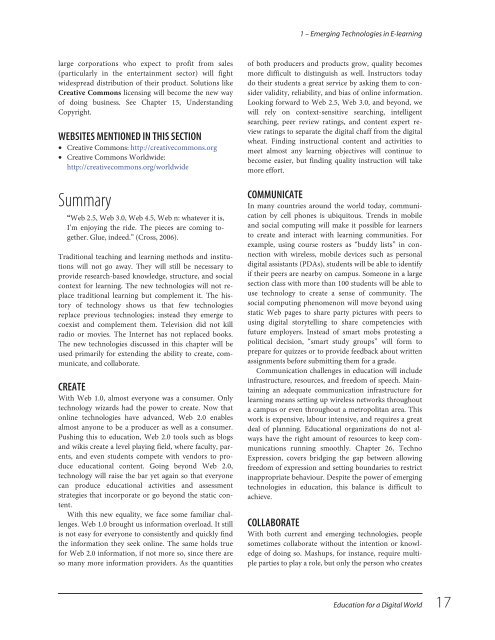Education for a Digital World Advice, Guidelines and Effective Practice from Around Globe, 2008a
Education for a Digital World Advice, Guidelines and Effective Practice from Around Globe, 2008a
Education for a Digital World Advice, Guidelines and Effective Practice from Around Globe, 2008a
Create successful ePaper yourself
Turn your PDF publications into a flip-book with our unique Google optimized e-Paper software.
1 – Emerging Technologies in E-learning<br />
large corporations who expect to profit <strong>from</strong> sales<br />
(particularly in the entertainment sector) will fight<br />
widespread distribution of their product. Solutions like<br />
Creative Commons licensing will become the new way<br />
of doing business. See Chapter 15, Underst<strong>and</strong>ing<br />
Copyright.<br />
WEBSITES MENTIONED IN THIS SECTION<br />
• Creative Commons: http://creativecommons.org<br />
• Creative Commons <strong>World</strong>wide:<br />
http://creativecommons.org/worldwide<br />
Summary<br />
“Web 2.5, Web 3.0, Web 4.5, Web n: whatever it is,<br />
I’m enjoying the ride. The pieces are coming together.<br />
Glue, indeed.” (Cross, 2006).<br />
Traditional teaching <strong>and</strong> learning methods <strong>and</strong> institutions<br />
will not go away. They will still be necessary to<br />
provide research-based knowledge, structure, <strong>and</strong> social<br />
context <strong>for</strong> learning. The new technologies will not replace<br />
traditional learning but complement it. The history<br />
of technology shows us that few technologies<br />
replace previous technologies; instead they emerge to<br />
coexist <strong>and</strong> complement them. Television did not kill<br />
radio or movies. The Internet has not replaced books.<br />
The new technologies discussed in this chapter will be<br />
used primarily <strong>for</strong> extending the ability to create, communicate,<br />
<strong>and</strong> collaborate.<br />
CREATE<br />
With Web 1.0, almost everyone was a consumer. Only<br />
technology wizards had the power to create. Now that<br />
online technologies have advanced, Web 2.0 enables<br />
almost anyone to be a producer as well as a consumer.<br />
Pushing this to education, Web 2.0 tools such as blogs<br />
<strong>and</strong> wikis create a level playing field, where faculty, parents,<br />
<strong>and</strong> even students compete with vendors to produce<br />
educational content. Going beyond Web 2.0,<br />
technology will raise the bar yet again so that everyone<br />
can produce educational activities <strong>and</strong> assessment<br />
strategies that incorporate or go beyond the static content.<br />
With this new equality, we face some familiar challenges.<br />
Web 1.0 brought us in<strong>for</strong>mation overload. It still<br />
is not easy <strong>for</strong> everyone to consistently <strong>and</strong> quickly find<br />
the in<strong>for</strong>mation they seek online. The same holds true<br />
<strong>for</strong> Web 2.0 in<strong>for</strong>mation, if not more so, since there are<br />
so many more in<strong>for</strong>mation providers. As the quantities<br />
of both producers <strong>and</strong> products grow, quality becomes<br />
more difficult to distinguish as well. Instructors today<br />
do their students a great service by asking them to consider<br />
validity, reliability, <strong>and</strong> bias of online in<strong>for</strong>mation.<br />
Looking <strong>for</strong>ward to Web 2.5, Web 3.0, <strong>and</strong> beyond, we<br />
will rely on context-sensitive searching, intelligent<br />
searching, peer review ratings, <strong>and</strong> content expert review<br />
ratings to separate the digital chaff <strong>from</strong> the digital<br />
wheat. Finding instructional content <strong>and</strong> activities to<br />
meet almost any learning objectives will continue to<br />
become easier, but finding quality instruction will take<br />
more ef<strong>for</strong>t.<br />
COMMUNICATE<br />
In many countries around the world today, communication<br />
by cell phones is ubiquitous. Trends in mobile<br />
<strong>and</strong> social computing will make it possible <strong>for</strong> learners<br />
to create <strong>and</strong> interact with learning communities. For<br />
example, using course rosters as “buddy lists” in connection<br />
with wireless, mobile devices such as personal<br />
digital assistants (PDAs), students will be able to identify<br />
if their peers are nearby on campus. Someone in a large<br />
section class with more than 100 students will be able to<br />
use technology to create a sense of community. The<br />
social computing phenomenon will move beyond using<br />
static Web pages to share party pictures with peers to<br />
using digital storytelling to share competencies with<br />
future employers. Instead of smart mobs protesting a<br />
political decision, “smart study groups” will <strong>for</strong>m to<br />
prepare <strong>for</strong> quizzes or to provide feedback about written<br />
assignments be<strong>for</strong>e submitting them <strong>for</strong> a grade.<br />
Communication challenges in education will include<br />
infrastructure, resources, <strong>and</strong> freedom of speech. Maintaining<br />
an adequate communication infrastructure <strong>for</strong><br />
learning means setting up wireless networks throughout<br />
a campus or even throughout a metropolitan area. This<br />
work is expensive, labour intensive, <strong>and</strong> requires a great<br />
deal of planning. <strong>Education</strong>al organizations do not always<br />
have the right amount of resources to keep communications<br />
running smoothly. Chapter 26, Techno<br />
Expression, covers bridging the gap between allowing<br />
freedom of expression <strong>and</strong> setting boundaries to restrict<br />
inappropriate behaviour. Despite the power of emerging<br />
technologies in education, this balance is difficult to<br />
achieve.<br />
COLLABORATE<br />
With both current <strong>and</strong> emerging technologies, people<br />
sometimes collaborate without the intention or knowledge<br />
of doing so. Mashups, <strong>for</strong> instance, require multiple<br />
parties to play a role, but only the person who creates<br />
<strong>Education</strong> <strong>for</strong> a <strong>Digital</strong> <strong>World</strong> 17


















